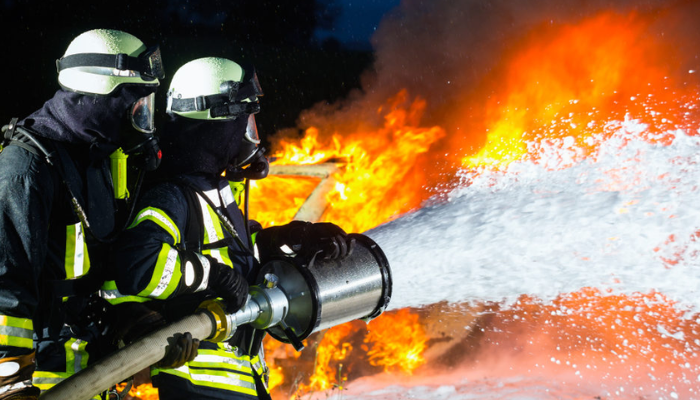In recent years, the firefighting community has grappled with an alarming crisis linked to using firefighting foam. Once hailed as a life-saving innovation, this foam is now scrutinized for its toxic nature and far-reaching consequences. That’s because of forever chemicals or per- and polyfluoroalkyl substances (PFAS) in firefighting foam.
The consequences of exposure to PFAS can be devastating. In response to that, the Environmental Protection Agency (EPA) has released an update about more than 900 spills or use of AFFFs reported in the US. It showed that these spills have managed to make their way into US waterways. The agency has educated the companies and the people about PFAS and the health issues related to firefighting foam.
This article delves into the heart of the matter, listing what’s driving the ongoing firefighter lawsuit against foam manufacturers and government agencies.
Unmasking the Hazards Associated With Firefighting Foams
The story of firefighting foam takes a grim turn as researchers and scientists begin unmasking the hazards associated with its widespread use. For decades, this foam was hailed as an essential tool in combating dangerous fires, particularly those fueled by flammable liquids. Its effectiveness in forming a blanket over burning substances to suppress flames seemed unparalleled, earning it a coveted spot in firefighting arsenals.
However, as fire departments relied heavily, reports of adverse health effects among firefighters started to surface. Concerns about exposure to potentially toxic chemicals in the foam’s formulation were raised. Investigations intensified, aiming to uncover the root causes of these health issues.
Studies revealed the presence of per- and polyfluoroalkyl substances (PFAS) in firefighting foam. PFAS are a group of synthetic chemicals known for their resistance to heat, water, and oil, making them ideal for firefighting applications. However, PFAS have been labeled “forever chemicals” due to their long-lasting persistence in the environment and the human body.
These chemicals have been associated with numerous health problems. TorHoerman Law’s website states that PFAS chemicals in AFFF are linked with multiple cancers, including kidney, testicular, pancreatic, bladder, prostate, and more. Based on studies proving the relationship between AFFF and health issues, several plaintiffs have filed lawsuits against manufacturing companies.
Moreover, as fires were extinguished, the remaining foam residues found their way into the environment, contaminating soil and groundwater. This raised additional alarm bells as communities near fire training facilities were at risk of water contamination with PFAS and other chemicals.
Unmasking these hazards led to a critical reassessment of firefighting practices. That forced agencies to confront the stark reality of the foam’s detrimental effects on firefighters’ health and the environment.
Many states also started implementing programs to prevent excessive exposure to firefighting foams. Michigan was among the first states to launch a state-wide Class B AFFF Pickup and Disposal Program. As of April 2023, Michigan had collected over 60,000 gallons of residual AFFF from the environment.
Legal Action and Accountability
As the evidence of the hazards posed by firefighting foam and its toxic components became more evident, the affected parties sought accountability and justice through legal channels. This led to a surge in lawsuits against firefighting foam manufacturers and government entities responsible for its regulation and oversight.
Many firefighter foam lawsuits have been filed over the years. In fact, due to the sheer number of cases, these lawsuits were consolidated into multidistrict litigation (MDL). The plaintiffs alleged manufacturers of not warning them about the potential health risks. Anyone who has developed any cancer or other health issue after exposure to AFFF can file a firefighter foam lawsuit.
However, you may face challenges getting the settlement amount if you don’t hire the right lawyer. For firefighters who developed health issues related, proving a link between their illnesses and the specific chemicals in firefighting foam required extensive medical evidence. This often involved complex scientific analysis and investigations into the individual circumstances of each case.
Responding to the mounting lawsuits and public pressure, some foam manufacturers settled out of court to avoid prolonged legal battles. These settlements compensated affected parties for medical expenses, lost wages, and other damages incurred due to exposure to the toxic foam. 3M and many US cities tentatively agreed to a settlement of $10 billion over water pollution claims involving PFAS.
The Fight for Regulations and Alternatives
Regulations and guidelines surrounding the use of firefighting foam had been relatively lax for years. This was primarily due to the focus on its effectiveness in combating fires. However, emerging health and environmental concerns demanded reevaluating existing practices. Advocacy groups urged government agencies to take a proactive approach in reassessing the risk-benefit balance of firefighting foam usage.
In response to public pressure and legal challenges, some governments and regulatory bodies began implementing measures to control the use of toxic firefighting foam. This included banning or restricting the use of specific foam formulations that contained particularly hazardous chemicals. In addition, there were calls for improved training and education for firefighters to minimize their exposure to foam during fire suppression operations.
The push for regulations also extended to the disposal of firefighting foam and foam-contaminated materials. Proper handling and containment of foam residues became a priority to prevent further environmental contamination and potential health risks. Fire departments were encouraged to adopt best practices for foam disposal.
Impact on Firefighting Practices
The revelations surrounding the hazards of firefighting foam and the legal battles that ensued profoundly impacted firefighting practices worldwide. Fire departments and agencies were forced to reevaluate their approach to fire suppression. They had to make significant changes to protect the health and safety of their personnel and the communities they serve.
- Safety protocols and training: Firefighters received enhanced training on handling firefighting foam safely. They learned about the potential risks of exposure to toxic chemicals and were educated on best practices for using and disposing of foam. Safety protocols were updated to minimize the risks associated with foam usage during training exercises and actual firefighting operations.
- Personal Protective Equipment (PPE): Firefighters’ protective equipment was upgraded to provide better protection against foam exposure. Firefighters were made aware of the importance of PPE, and it was mandated to use them. A study reveals that more than 90% of firefighters wear PPE kits. Improved gear and respiratory equipment were introduced to reduce the risk of inhalation or skin contact with foam residues. Firefighters were encouraged to follow proper decontamination procedures after each incident involving foam.
- Safer foam alternatives: As safer alternatives emerged, fire departments gradually transitioned away from traditional foams containing PFAS and other hazardous substances. Adopting these alternatives became more widespread as their effectiveness and safety were demonstrated through research and real-world use.
- Environmental considerations: Fire departments started considering the environmental impact of firefighting foam. Training facilities were equipped with containment systems to prevent foam residues from leaching into the soil and groundwater. Proper disposal practices for foam-contaminated materials were implemented to mitigate environmental contamination.
- Risk-benefit analysis: Fire departments began conducting comprehensive risk-benefit analyses before using firefighting foam. The decision to deploy foam weighed against its potential hazards to human health and the environment. In some cases, alternative firefighting strategies that minimized foam usage were employed.
Conclusion
The toxic firefighting foam issue ignited a chain reaction of change within the firefighting community, prompting a reevaluation of practices and regulations. From unmasking its hazards to the legal battles seeking accountability, this crisis exposed the need for safer alternatives and increased environmental responsibility.
The impact on firefighting practices led to improved safety protocols, the adoption of innovative foam alternatives, and a global push for more stringent regulations. As the industry continues to evolve, this turning point is a testament to the power of collective action. It’s also a commitment to safeguarding the brave firefighters and the communities they serve.





















Comments